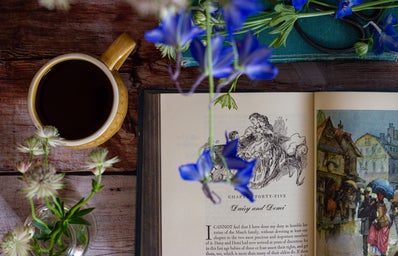Hear me out: Colleen Hoover’s It Ends With Us bestselling book is a bit overhyped. I understand that this may be controversial, seeing as her books, and this one specifically, single-handedly took over BookTok for weeks. However I must admit, I was disappointed when picking up this book. From everything I had seen on social media and heard from my friends–granted, few of them read regularly – I was expecting Hoover’s book to be borderline phenomenal. It’s not so much that the book wasn’t good, I just found it to be somewhat basic and inauthentic.
It Ends With Us starts with a fairly overused theme; a girl, Lily Bloom, meets a handsome, mysterious guy, Ryle Kincaid, in an unlikely and vulnerable situation. This puts them in a position where they are already closer than the average strangers. She finds out he’s not only handsome but smart, wealthy, and single. However, he isn’t emotionally available…shocker. Several months after their first encounter – which was quite eventful and most certainly unrealistic – they meet again when the handsome stranger’s sister comes into Lily’s flower shop in pursuit of a job. In an extremely predictable manner, Ryle, who made it very clear he’s simply not programmed for relationships, falls in love with Lily and claims to have never felt like this before, only ever wanting hookups in the past. His trope was very much a “hating everyone but her,” “emotionally unavailable except for her,” and “she can fix me” type of vibe. This predictability made the story extremely anticlimactic, and it felt like a worn-out topic. The whole book gave me flashbacks to The Kissing Booth, To All The Boys I’ve Loved Before, and most other Netflix Original movies, not because of their plots but because of the cheesiness. It felt like the book was targeted towards middle schoolers but with adult-like topics.
In It Ends With Us, there is a lot of mention of abuse, sexual assault, and domestic violence. All things considered, she portrays these situations well, allowing the reader to sympathize and better understand why it is so difficult for people in abusive relationships to leave, despite how easy it may seem. Even with these topics being a focal point in the book, I never felt like I knew how the main character felt emotionally; I knew she was hurt, angry, and heartbroken, but I felt like there should have been more intensity and description with how these things affected her.
Another area I wasn’t super fond of was the dialogue. The conversations the main characters have with one another don’t sound like conversations any 30-year-olds would have, or at least not in the way they were speaking. At one point in the book, I was taken back by how childish one of the characters sounded, boasting about how she and her now–husband made out for hours when they were in high school, as if that’s something grown women with a child on the way brag about. On top of the characters both acting and talking like middle schoolers, I couldn’t seem to imagine what they looked like. I don’t tend to struggle to imagine characters when there is enough descriptive imagery where I can make out the details beyond whether they have long or short hair, what color the hair is, their skin color, and how tall they are. Hoover hardly described the nitty gritty that turns a character’s face from a blob of blurry disfigured features to a real human face. There was little to no mention of the slope of the nose, shape of the lips, distinctive freckles, the structure of face, or shade of skin. Part of reading a good book is knowing what the characters look like and being able to imagine them as a real person, and I never felt like I had that connection throughout the book. The setting wasn’t any better. Halfway through the book, I realized I had no idea what her apartment looked like, so I had been imagining it as my own apartment. Hoover’s best scenic imagery in the book is when she describes the flower shop Lily’s opening: “paint them dark purple with black accents…put out displays of darker flowers in things like leather or silver chains…we’ll stick them in black onyx…purple velvet vases lined with silver studs.” Her passion and endless ideas for the flower shop create an image that helps the reader envision her dream and the vibe of the place,but this type of passion and intense imagery is a rarity in this book. In some of Hoover’sother books, such as Ugly Love, she is much more descriptive. She describes one of the characters in a beautifully poetic way: “I come to the conclusion that his appearance is completely contradictory. It’s as if two different creators were at war when he was envisioned. The strength in his bone structure contrasts with the soft, inviting appeal of his lips. They seem harmless and welcoming compared with the harshness in his features and the jagged scar that runs the length of the right side of his jaw…His hair can’t decide if it wants to be brown or blond or wavy or straight.”She continues this way of metaphorical imagery when she describes the shade of his blue eyes and how they remind her of the Caribbean.
It’s that type of narration that builds a real person, a character that can be so easily envisioned. It Ends With Us lacked that important theme. Frankly, the best descriptions in the entire book are when she describes the sex scenes. The smut felt like a WattPad story or reading women-focused porn, which seems to be a common topic in her books and a popular selling point. While I do agree that the book was entertaining and certainly had many emotional parts that felt like a punch to the gut, overall, the book felt like it was juvenile and rushed.


